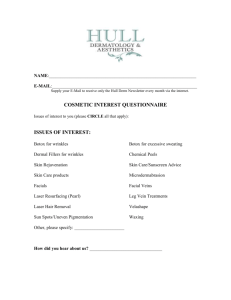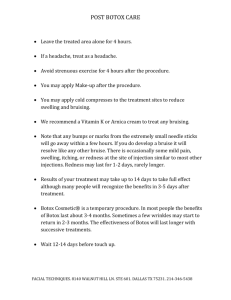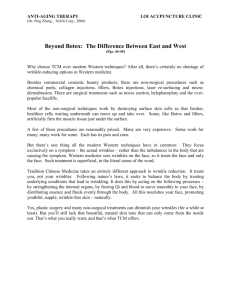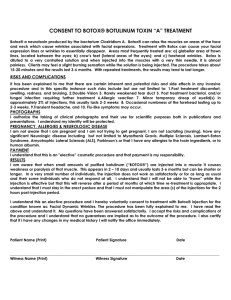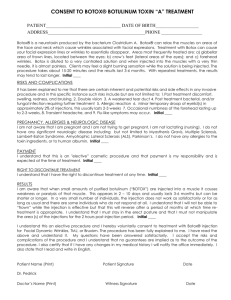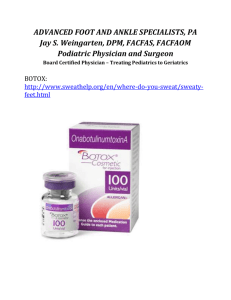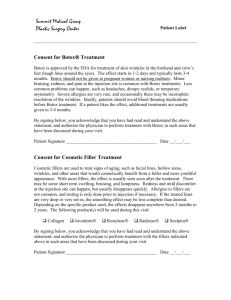Botox
advertisement
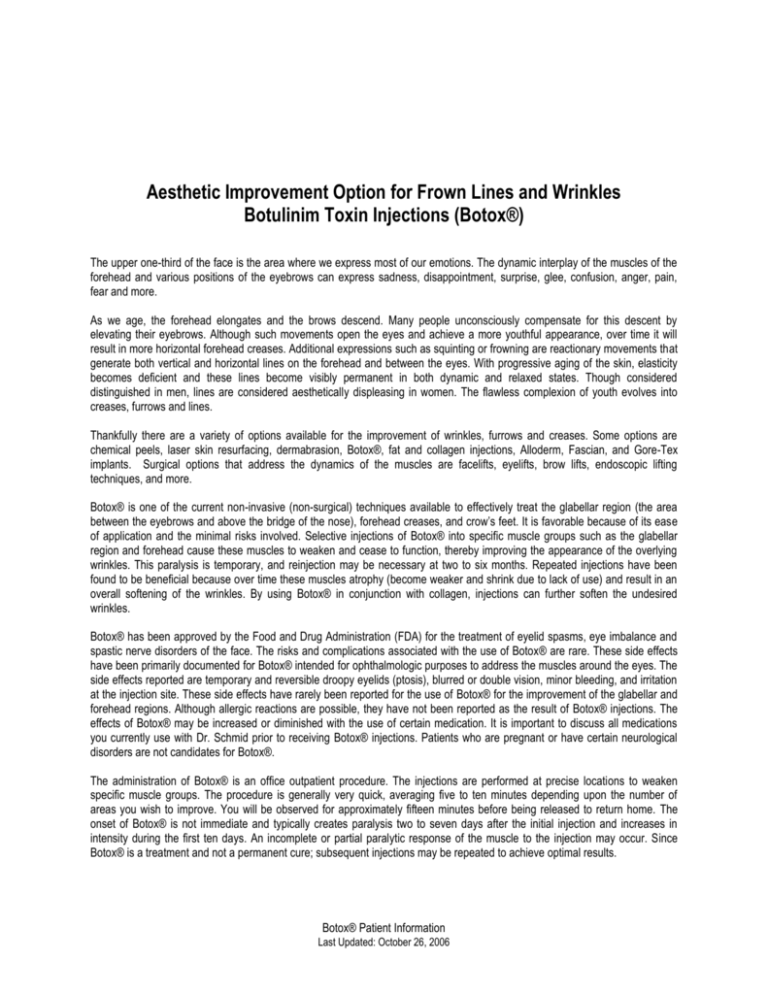
Aesthetic Improvement Option for Frown Lines and Wrinkles Botulinim Toxin Injections (Botox®) The upper one-third of the face is the area where we express most of our emotions. The dynamic interplay of the muscles of the forehead and various positions of the eyebrows can express sadness, disappointment, surprise, glee, confusion, anger, pain, fear and more. As we age, the forehead elongates and the brows descend. Many people unconsciously compensate for this descent by elevating their eyebrows. Although such movements open the eyes and achieve a more youthful appearance, over time it will result in more horizontal forehead creases. Additional expressions such as squinting or frowning are reactionary movements that generate both vertical and horizontal lines on the forehead and between the eyes. With progressive aging of the skin, elasticity becomes deficient and these lines become visibly permanent in both dynamic and relaxed states. Though considered distinguished in men, lines are considered aesthetically displeasing in women. The flawless complexion of youth evolves into creases, furrows and lines. Thankfully there are a variety of options available for the improvement of wrinkles, furrows and creases. Some options are chemical peels, laser skin resurfacing, dermabrasion, Botox®, fat and collagen injections, Alloderm, Fascian, and Gore-Tex implants. Surgical options that address the dynamics of the muscles are facelifts, eyelifts, brow lifts, endoscopic lifting techniques, and more. Botox® is one of the current non-invasive (non-surgical) techniques available to effectively treat the glabellar region (the area between the eyebrows and above the bridge of the nose), forehead creases, and crow’s feet. It is favorable because of its ease of application and the minimal risks involved. Selective injections of Botox® into specific muscle groups such as the glabellar region and forehead cause these muscles to weaken and cease to function, thereby improving the appearance of the overlying wrinkles. This paralysis is temporary, and reinjection may be necessary at two to six months. Repeated injections have been found to be beneficial because over time these muscles atrophy (become weaker and shrink due to lack of use) and result in an overall softening of the wrinkles. By using Botox® in conjunction with collagen, injections can further soften the undesired wrinkles. Botox® has been approved by the Food and Drug Administration (FDA) for the treatment of eyelid spasms, eye imbalance and spastic nerve disorders of the face. The risks and complications associated with the use of Botox® are rare. These side effects have been primarily documented for Botox® intended for ophthalmologic purposes to address the muscles around the eyes. The side effects reported are temporary and reversible droopy eyelids (ptosis), blurred or double vision, minor bleeding, and irritation at the injection site. These side effects have rarely been reported for the use of Botox® for the improvement of the glabellar and forehead regions. Although allergic reactions are possible, they have not been reported as the result of Botox® injections. The effects of Botox® may be increased or diminished with the use of certain medication. It is important to discuss all medications you currently use with Dr. Schmid prior to receiving Botox® injections. Patients who are pregnant or have certain neurological disorders are not candidates for Botox®. The administration of Botox® is an office outpatient procedure. The injections are performed at precise locations to weaken specific muscle groups. The procedure is generally very quick, averaging five to ten minutes depending upon the number of areas you wish to improve. You will be observed for approximately fifteen minutes before being released to return home. The onset of Botox® is not immediate and typically creates paralysis two to seven days after the initial injection and increases in intensity during the first ten days. An incomplete or partial paralytic response of the muscle to the injection may occur. Since Botox® is a treatment and not a permanent cure; subsequent injections may be repeated to achieve optimal results. Botox® Patient Information Last Updated: October 26, 2006
